Groundwater Characteristics and Quality in the Coastal Zone of Lomé, Togo
Abstract
1. Introduction
2. Materials and Methods
2.1. Study Area
2.2. Site Selection and Sampling
2.3. Method of Collection
2.4. Parameters Analyzed
- Animal origin (R < 0.7);
- Human R > 4;
- Mixed when 0.7 < R < 1;
- Uncertain origin when 1 < R < 2;
- Mixed predominantly human 2 < R < 4.
3. Results
3.1. Physicochemical Characteristics of Groundwater in the Lower Town of Lomé
3.2. Bacteriological Characteristics of Groundwater in the Lower Town of Lomé
- -
- The Nyékonakpoè well exhibits human-origin pollution during the short dry season and contamination of uncertain origin in other seasons.
- -
- Kodjoviakopé shows animal-derived contamination during the short and long dry seasons and animal contamination in the rainy season.
- -
- Hanoukopé, Amoutivé, Ablogamé, and Souza Nétimé wells are consistently polluted by human sources year round.
- -
- In Wetrivikondji, contamination is human related, except in the long dry season, when it is of mixed origin.
- -
- The Béniglato and Gbényédji 1 wells are affected by animal-origin contamination during the long rainy season and human-origin contamination during other periods.
- -
- In Gbényédji 2, pollution is primarily of animal origin year round, except during the short dry season.
- -
- Akodessewa Kpota is characterized by human-origin contamination throughout the year, except in the long dry season, when the source is animals.
4. Discussion
5. Conclusions
Author Contributions
Funding
Data Availability Statement
Conflicts of Interest
References
- Förster, T.; Ammann, C. «African Cities and the Development Puzzle.» International Development Policy Review [Online], Online Since 25 February 2020, Connection on 28 August 2023. 2018. Available online: http://journals.openedition.org/poldev/3352 (accessed on 28 August 2023).
- Sy, I.; Keita, M.; Traoré, D.; Koné, B.; Bâ, K.; Wedadi, O.B.; Fayomi, B.; Bonfoh, B.; Tanner, M.; Cissé, G. Water, Hygiene, Sanitation and Health in Precarious Neighborhoods in Nouakchott (Mauritania): Contribution to the Ecohealth Approach in Hay Saken. VertigO—the Electronic Journal in Environmental Sciences, 08: Special Issue 19. 2014. Available online: http://journals.openedition.org/vertigo/14999 (accessed on 28 August 2023).
- Niambele, D.; Diarra, O.; Bagayoko, M.W.; Samake, S.; Samake, F.; Babana, A.H. Evaluation of the Bacteriological Quality of the Drilling Water Analyzed at the National Health Laboratory during the First Half of 2019. Int. J. Sci. Res. (IJSR) 2020, 392–395. Available online: https://www.academia.edu/124829158/Evaluation_of_the_Bacteriological_Quality_of_the_Drilling_Water_Analyzed_at_the_National_Health_Laboratory_during_the_First_Half_of_2019 (accessed on 28 August 2023).
- Adetunde, L.A.; Glover, R.L.K. Evaluation of bacteriological quality of drinking water used by selected secondary schools in Navrongo in Kassena-Nankana district of upper east region of Ghana. Prime J. Microbiol. Res. 2011, 1, 47–51. [Google Scholar]
- Diallo, T. Bacteriogical Quality of Drinking Water. Doctoral Thesis, Pharmacy, Faculty of Medicine of Pharmacy and Odontostomatology, University of Bamako, Bamako, Mali, 2017; 32p. [Google Scholar]
- pS-Eau: Les Services d’eau et d’assainissement dans les objectifs de développement durable. Document de travail, Version octobre 2016. Available online: https://www.pseau.org/outils/ouvrages/ps_eau_services_eau_assainissement_odd_oct_2016.pdf (accessed on 28 August 2023).
- Singh, S.; Singh, B.B. Nutritional evaluation of fats and top foliages through in vitro system of sheep and goat for silvipasture system. Range Manag. Agroforest. 2017, 38, 241–248. [Google Scholar]
- Akpataku, K.V.; Masamaéya; Gnazou, D.T.; Nomesi, T.Y.A.; Nambo, P.; Doni, K.; Bawa, L.M.; Djaneye-Boundjou, G. Physicochemical and Microbiological Quality of Shallow Groundwater in Lomé, Togo. J. Geosci. Environ. Prot. 2020, 8, 2020. [Google Scholar]
- OCDE. La Gouvernance de l’Eau Dans les Villes Africaines, Études de l’OCDE sur L’Eau; Éditions OCDE: Paris, France, 2021. [Google Scholar] [CrossRef]
- RGPH. General Census of Population and Housing: Final Results; Institut National de la Statistique et des Études Économiques et Démographique: Lomé, Togo, 2022; 65p. [Google Scholar]
- Odeloui, D.; Nlend, B.; Huneau, F.; Celle, H.; Garel, E.; Alassane, A.; Boukari, M.; Sambienou, G. Insight into Groundwater Resources along the Coast of Benin (West Africa) through Geochemistry and Isotope Hydrology; Recommendations for Improved Management. Water 2022, 14, 2154. [Google Scholar] [CrossRef]
- Available online: https://www.lenntech.fr/applications/potable/normes/normes-oms-eau-potable.htm (accessed on 15 January 2023).
- Blivi, A. The constraints of the development of the Lomé site. The example of morphology. In The Centenary of Lomé, Capital of Togo (1897–1997); Gayibor, N., Marguerat, Y., Nyassogbo, K., Eds.; Université de Lomé: Lomé, Togo, 1998; pp. 175–188. [Google Scholar]
- UNDP. Groundwater Exploration in the Coastal Zone (TOGO): Conclusions and Recommendations; DP/UN/TOG-70-511/1; United Nations: New York, NY, USA, 1975; 83p + annexes. [Google Scholar]
- Gnazou, M.T.K. Hydrodynamic, Hydrochemical, Isotopic Study and Modeling of the Aquifer of the Coastal Sedimentary Basin of Togo. Doctoral Thesis, University of Lomé, Lomé, Togo, 2008; 204p. [Google Scholar]
- da Costa, P.Y.D.; Johnson, A.K.; Affaton, P. The Paleozoic and Mesozoic Terrains of the Togolese Coastal Basin: Stratigraphy and Paleogeography. Stand. Sci. Res. Essays 2013, 1, 415–429. [Google Scholar]
- Houédakor, K.Z. 2016—Dynamique hydrologique de la nappe des cordons sableux de Lomé. In Revue de Géographie du Laboratoire Leïdi; Université Gaston Berger: Saint Louis, Sénégal, 2016; pp. 201–222. [Google Scholar]
- Lalanne, F.; Fondation 2ie. Étude de la Qualité de l’Eau le Long de la Chaîne D’approvisionnement au Niveau des Consommateurs Dans 10 Villages de la Province du Ganzourgou, (Région du Plateau Central, Burkina Faso); UNICEF: New York, NY, USA, 2012; 81p. [Google Scholar]
- Sadowsky, M.J.; Whitman, R.L. The Fecal Bacteria; ASM Press: Washington, DC, USA, 2011. [Google Scholar]
- Piper, A.M. A graphic procedure in the geochemical interpretation of water analyses. Trans. Geophys. Union 1994, 25, 914–923. [Google Scholar]
- Holaly, G.E. Contribution to the Implementation of Sustainable Development Through Wastewater Management in Adétikopé, Togo. Doctoral Thesis, University of Lomé, Lomé, Togo, 2024. ED730_LH. 227p. [Google Scholar]
- Mwanza, P.B.; Katond, J.P.; Hanocq, P. Evaluation of the physicochemical and bacteriological quality of well water in the spontaneous district of Luwowoshi (DR Congo). Tropicultura 2019, 37. [Google Scholar] [CrossRef]
- Borrego, A.F.; Romero, P. Study of microbiological pollution of Malaga littoral area II, Relationship between fecal coliforms and fecal streptococci. VIth Day Stud. Pollut. Cannes 1982, 5, 561–569. [Google Scholar]
- Belghiti, M.L.; Chahlaoui, A.; Bengoumi, D. Study of the Physico-Chemical and Bacteriological Quality of Groundwater of the Plio-Quaternary Aquifer in the Meknes Region (Morocco). Larhyss J. 2013, 14, 21–36. [Google Scholar]
- Available online: https://cdn.standards.iteh.ai/samples/14838/0ab13208827b4b5cba4904a6908f2600/ISO-7888-1985.pdf (accessed on 15 January 2023).
- Available online: https://www.aquaportail.com/dictionnaire/definition/6776/solides-dissous-totaux (accessed on 15 January 2023).
- Moussa, K. Contribution to the Evolution of the Quality and Protection of Groundwater in the Paleocene Aquifers of the Continental Terminal and the Dune Sands of the Coastal Sedimentary Basin of Togo. Dissertation for Obtaining the Diploma of Works Engineer, University of Lomé, Lomé, Togo, 2000; p. 49. [Google Scholar]
- Machado, A.; Amorim, E.; Bordalo, A.A. Spatial and Seasonal Drinking Water Quality Assessment in a Sub-Saharan Country (Guinea-Bissau). Water 2022, 14, 1987. [Google Scholar] [CrossRef]
- Lanusse, A. 1987: Microbial Contamination of a Tropical Lagoon (Ébrié Lagoon, Ivory Coast). Influences of Hydroclimate. Ph.D. Thesis, University of Provence, Marseille, France, 1987; 147p. [Google Scholar]
- Available online: https://www.actu-environnement.com/media/pdf/news-29706-Esco-eutrophisation-synthese.pdf (accessed on 15 January 2023).
- Available online: https://iris.who.int/bitstream/handle/10665/42250/9242544809-part1-fre.pdf?sequence=2 (accessed on 15 January 2023).
- Moukolo, N. Systematic controls of the quality of natural waters in Congo: Some results from the hydraulics laboratory of ORSTOM/DGRST in Brazzaville. CIEH liaison bulletin, No. 20, PP 11-21. 1993. Available online: https://www.scirp.org/reference/referencespapers?referenceid=3517648 (accessed on 7 March 2025).
- Makoutode, M.; Assani, A.K.; Ouedo, E.M.; Agueh, V.D.; Diallo, P. Quality and management of water in rural areas in Benin: The case of the Grand-Popo sub-prefecture. Méd. D’Afrique Noire 1999, 46, 528–534. [Google Scholar]
- Traoré, O.; Kpoda, D.S.; Dembélé, R.; Saba, C.K.S.; Cairns, J.; Barro, N.; Haukka, K. Microbiological and Physicochemical Quality of Groundwater and Risk Factors for Its Pollution in Ouagadougou, Burkina Faso. Water 2023, 15, 3734. [Google Scholar] [CrossRef]
- Eka, A.B. Groundwater Quality, Deterioration Factors and Health Risks in the City of Lomé. Master’s Thesis, Geosciences and Management of Biophysical Environments, Department of Geography, University of Lomé, Lomé, Togo, 2020; 108p. [Google Scholar]
- Houédakor, K.Z. Water Resources: Geographical Study in the Volta-Mono Area. Doctoral Thesis, Letters and Human Sciences, Department of Geography, University of Lomé, Lomé, Togo, 2010; 380p. [Google Scholar]
- Koffi, Y.T. Urban Metabolism, Sanitation and Hygiene System and Health Risks in the Lower Town of Lomé. Master’s Thesis, Geosciences, Department of Geography, University of Lomé, Lomé, Togo, 2020; 108p. [Google Scholar]
- Soncy, K.; Djeri, B.; Anani, K.; Eklou-Lawson, M.; Adjra, Y.; Karou, D.S.; Améyapoh, Y.; de Souza, C. Assessment of the quality of well and borehole water in Lomé, Togo. J. Appl. Biosci. 2015, 91, 8464–8469. [Google Scholar] [CrossRef]
- Aka, N.; Bamba, S.B.; Soro, G.; Soro, N. Hydrochemical and microbiological study of alterite layers under humid tropical climate: Case of the Abengourou department (South-East of Ivory Coast). Larhyss J. 2013, 16, 31–52. [Google Scholar]
- Pandit, A.B.; Kumar, J.K. Clean water for developing countries. Annu. Rev. Chem. Biomol. Eng. 2015, 6, 217–246. [Google Scholar] [CrossRef] [PubMed]
- Boateng, P.D. Comparative Studies of the Use of Alum and Moringa Oleifera in Surface Water Treatment. Master’s Thesis, Department Civil English, Kwame Nkrumah University Science Technology, Kumasi, Ghana, 2001. [Google Scholar]
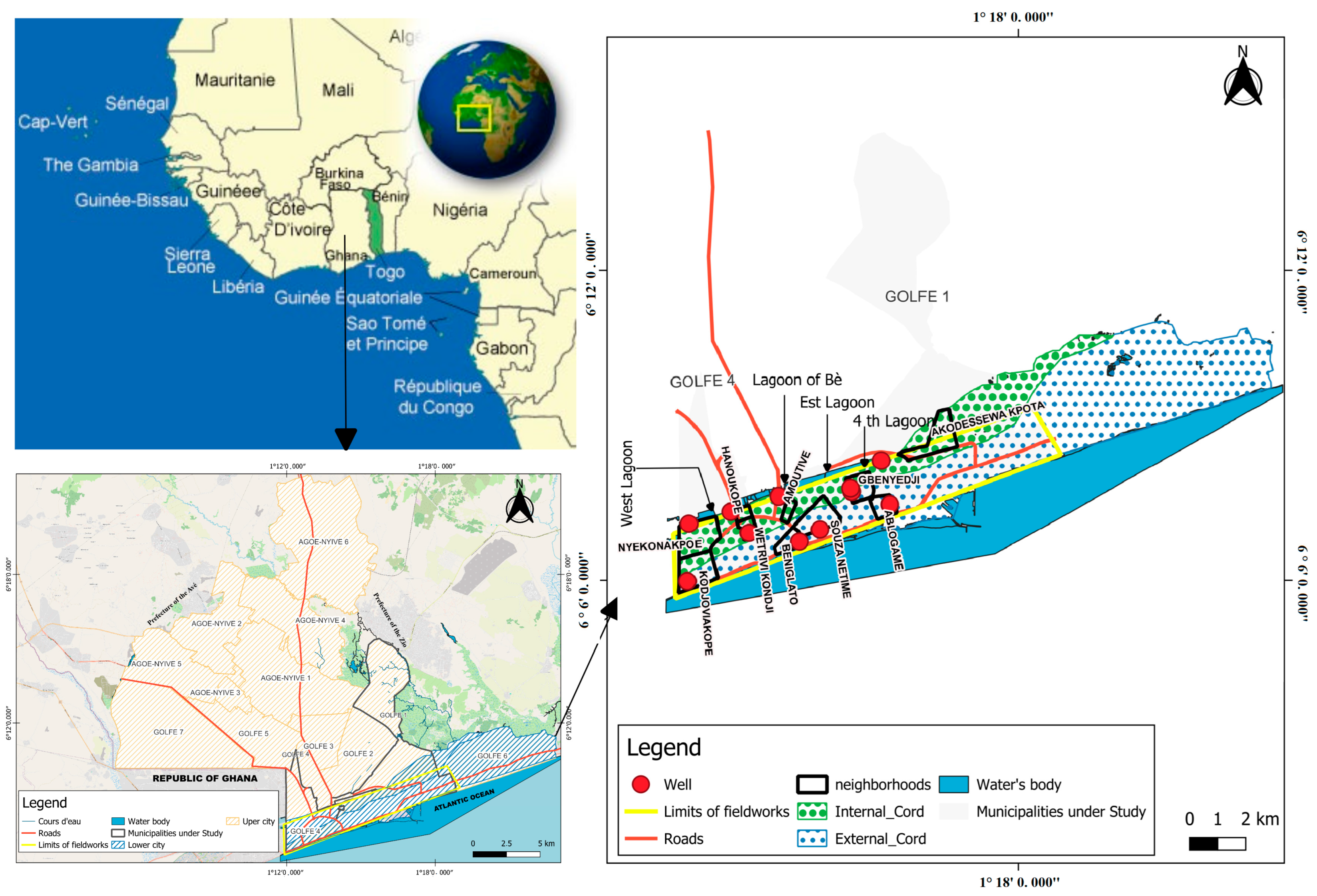
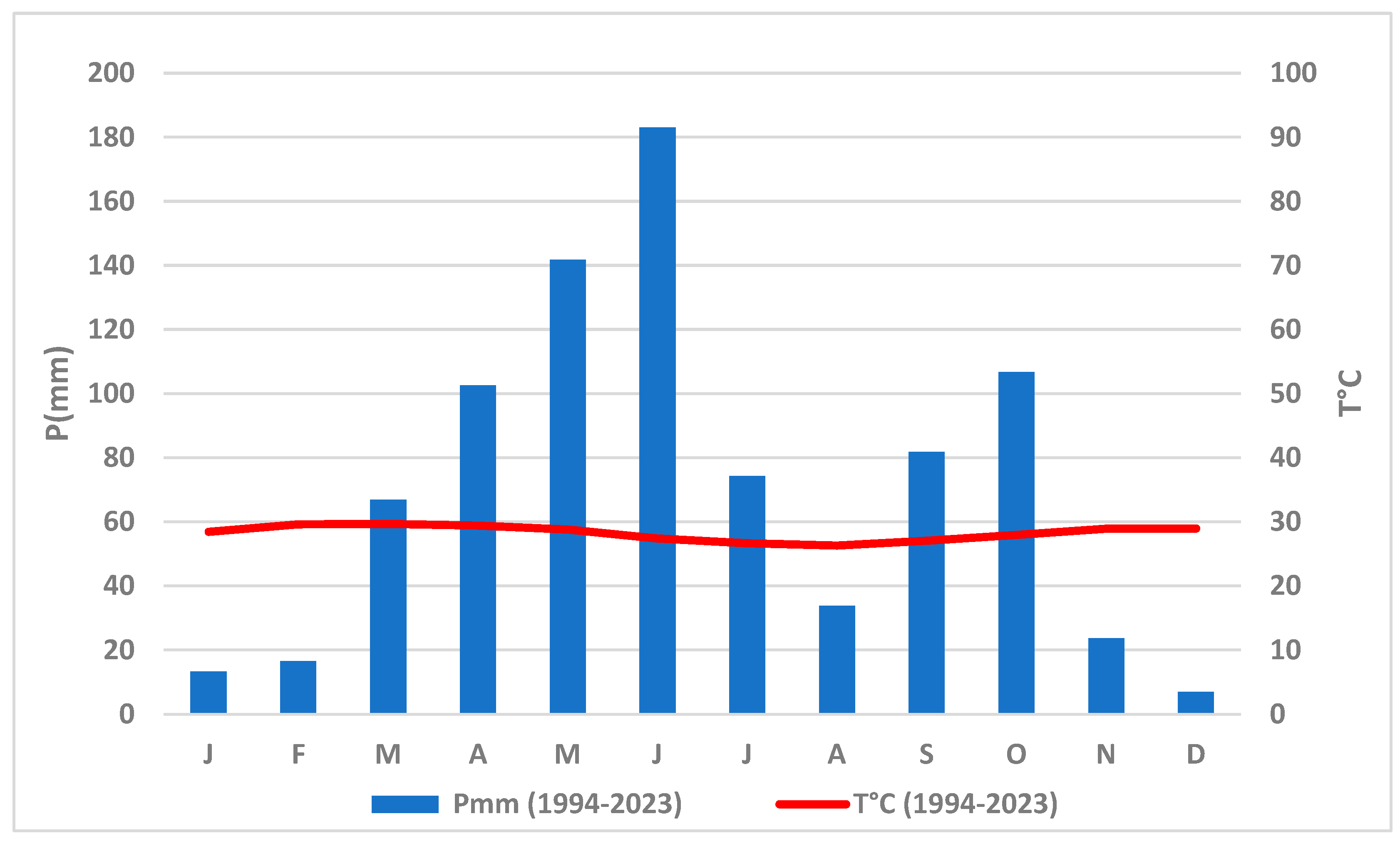
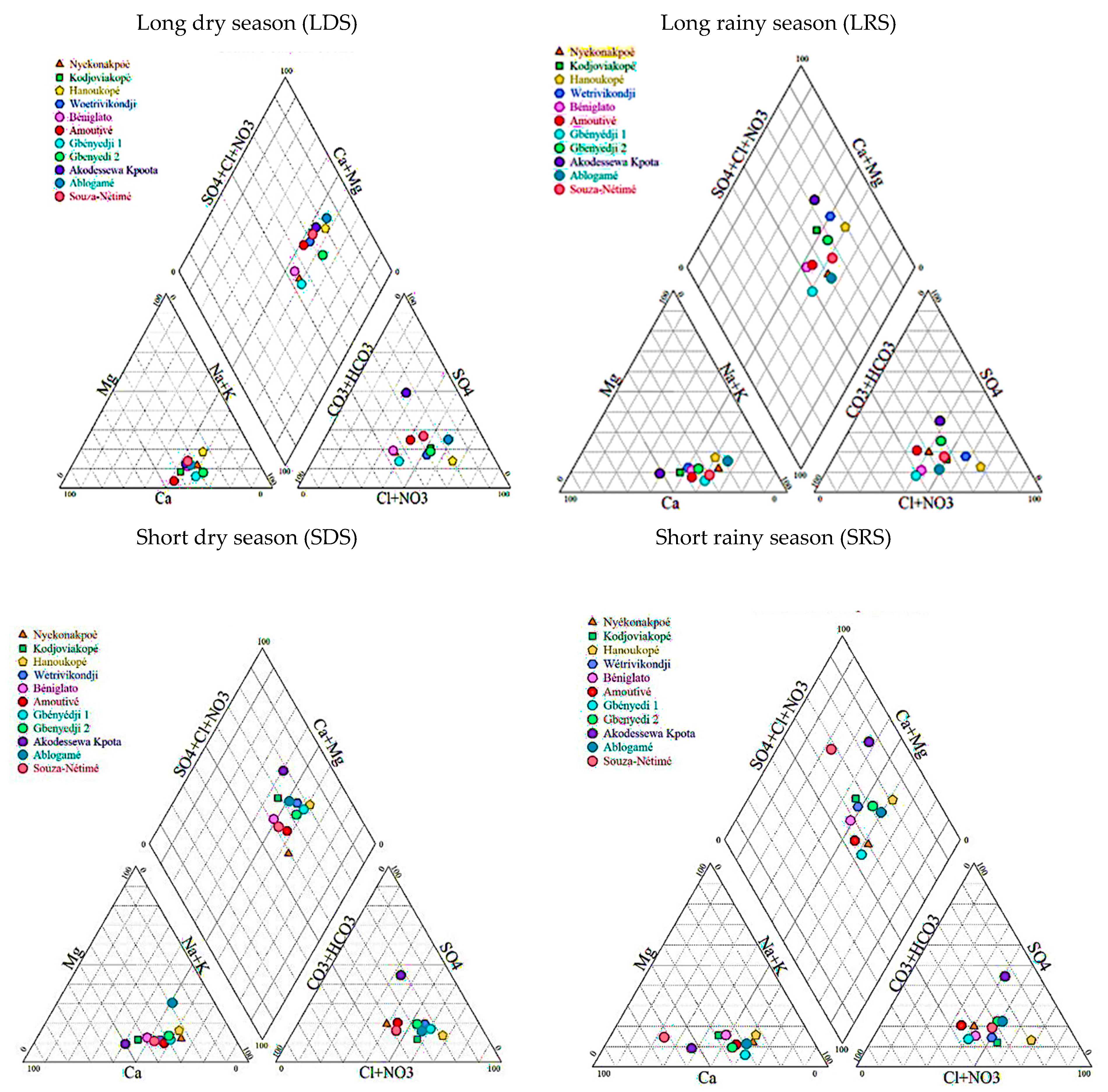
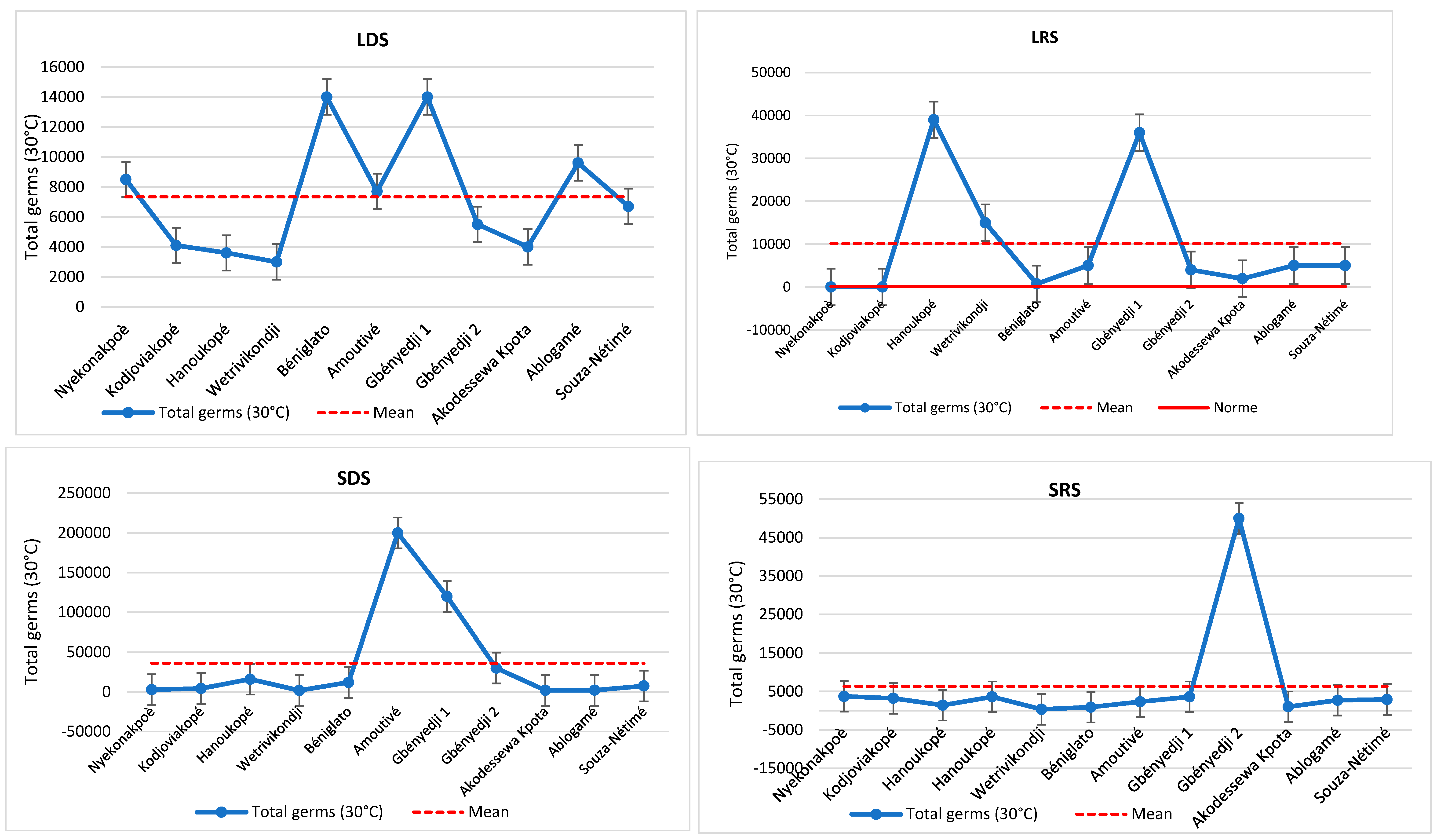
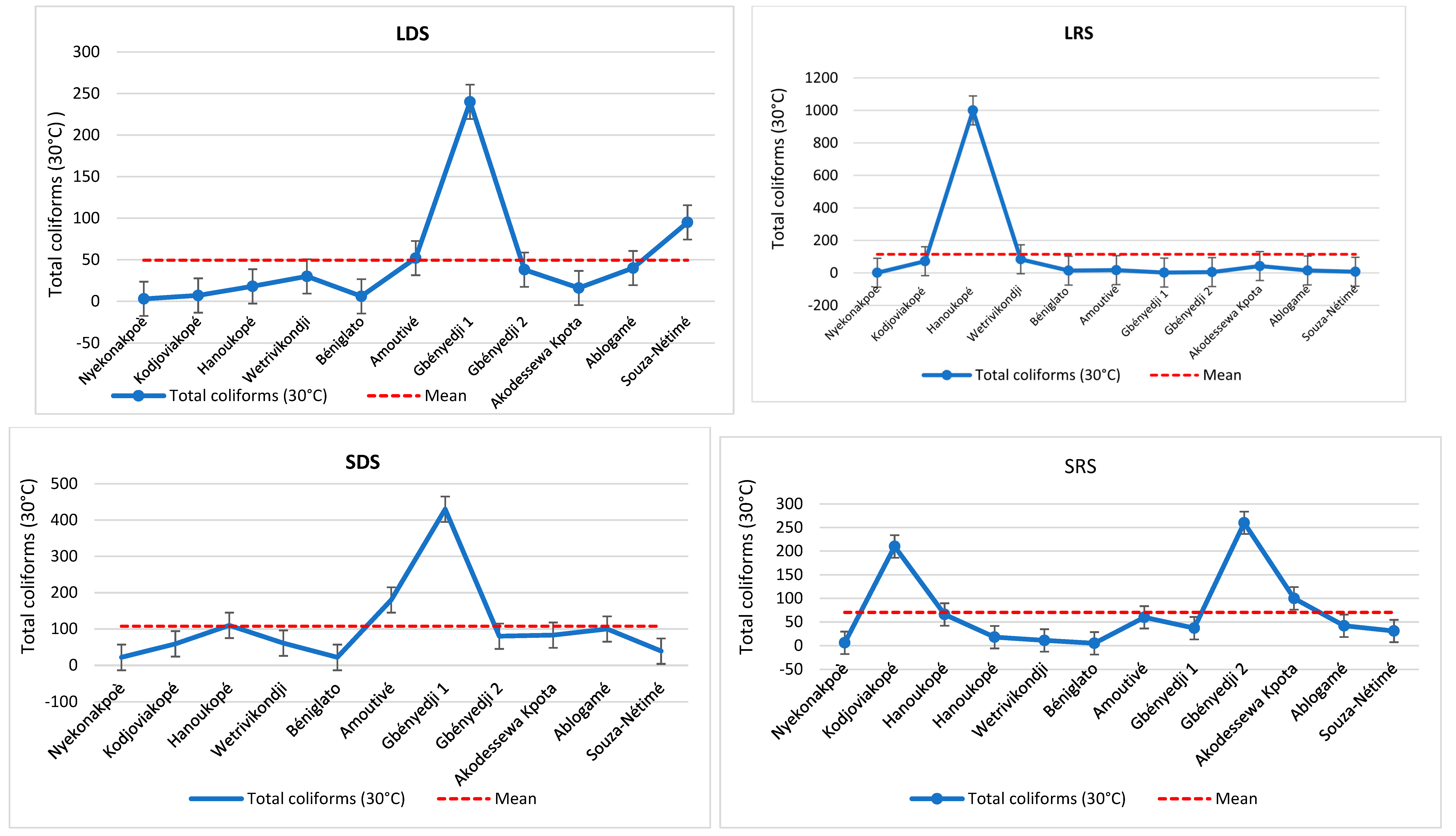
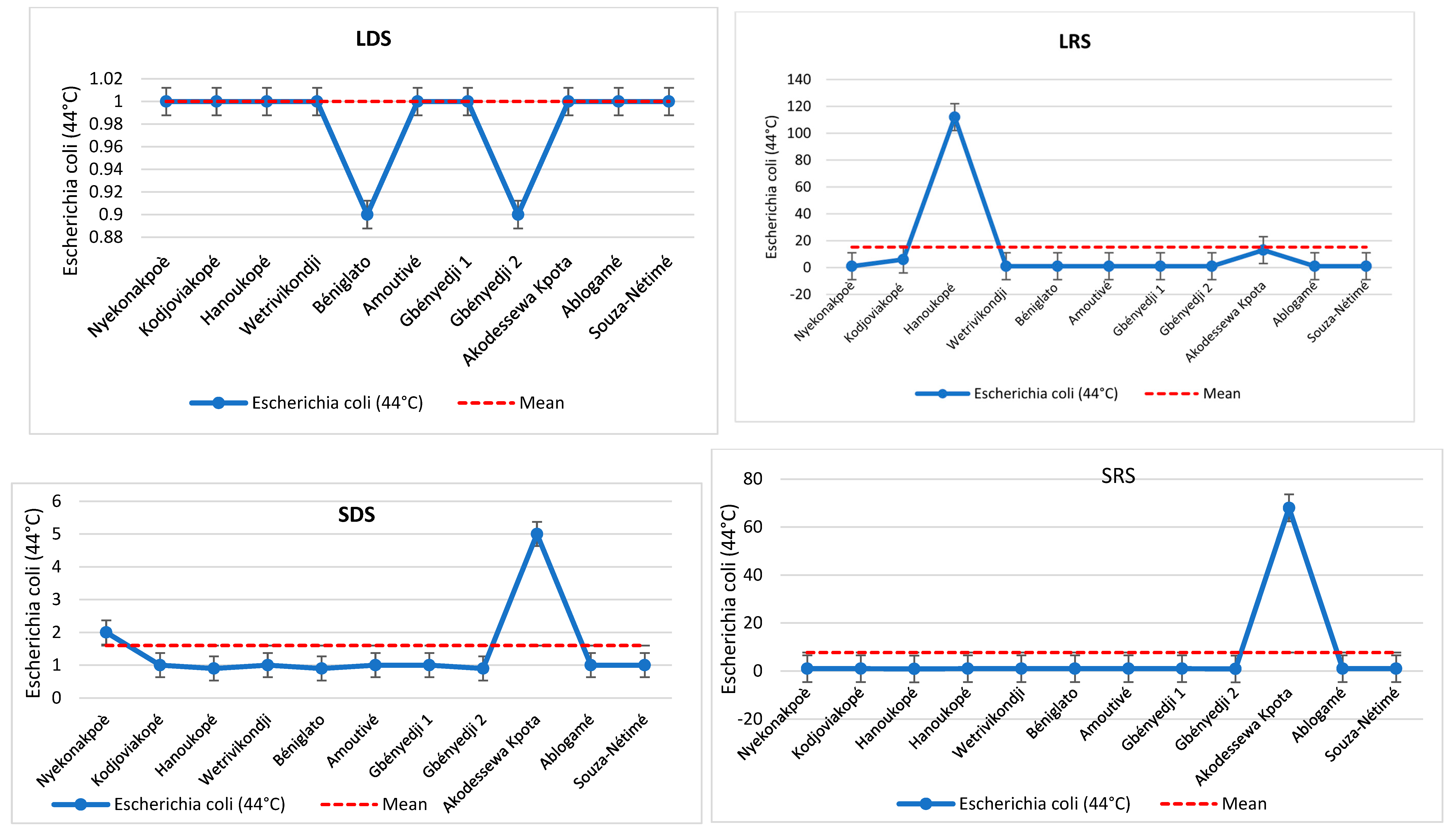
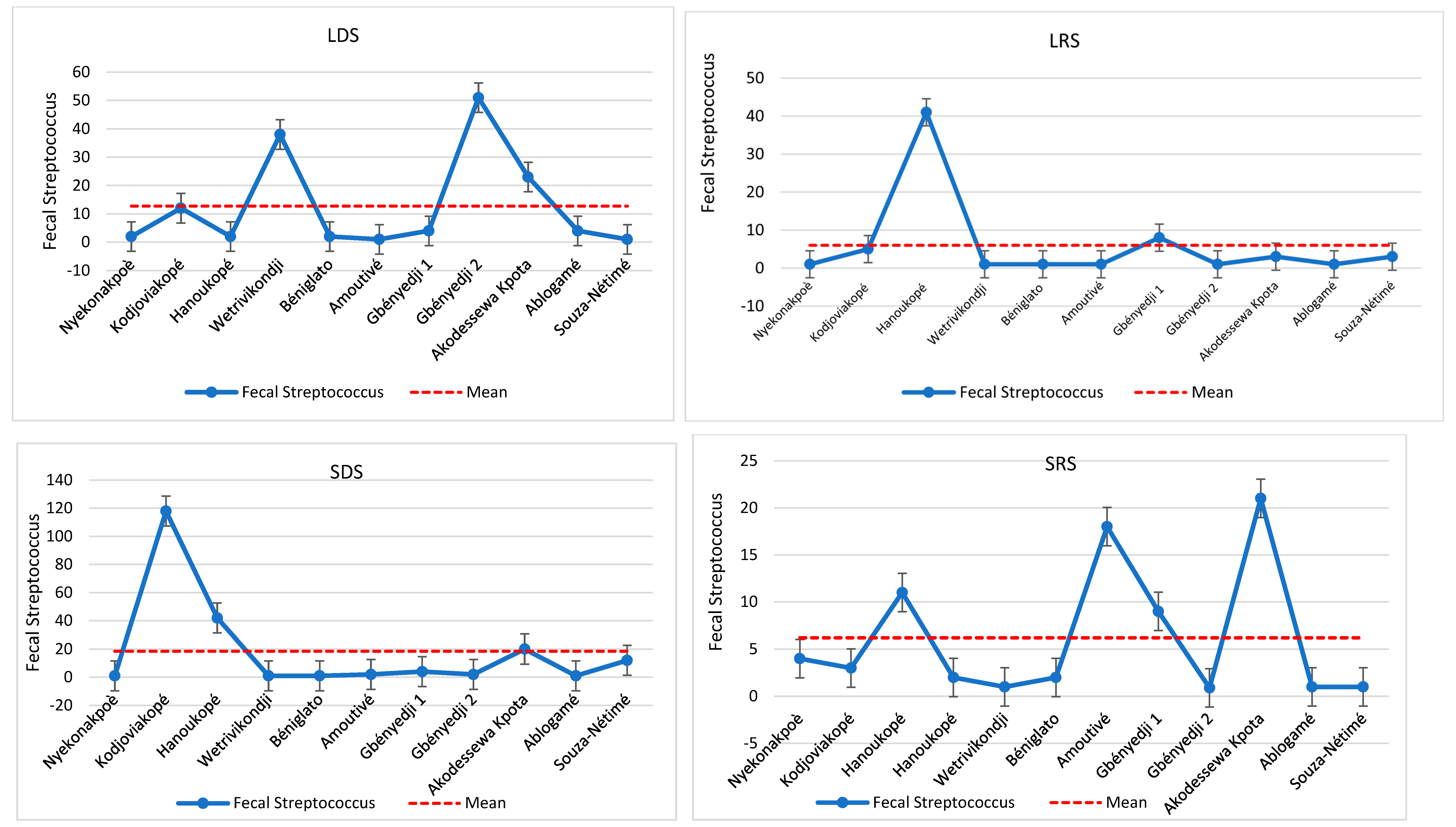
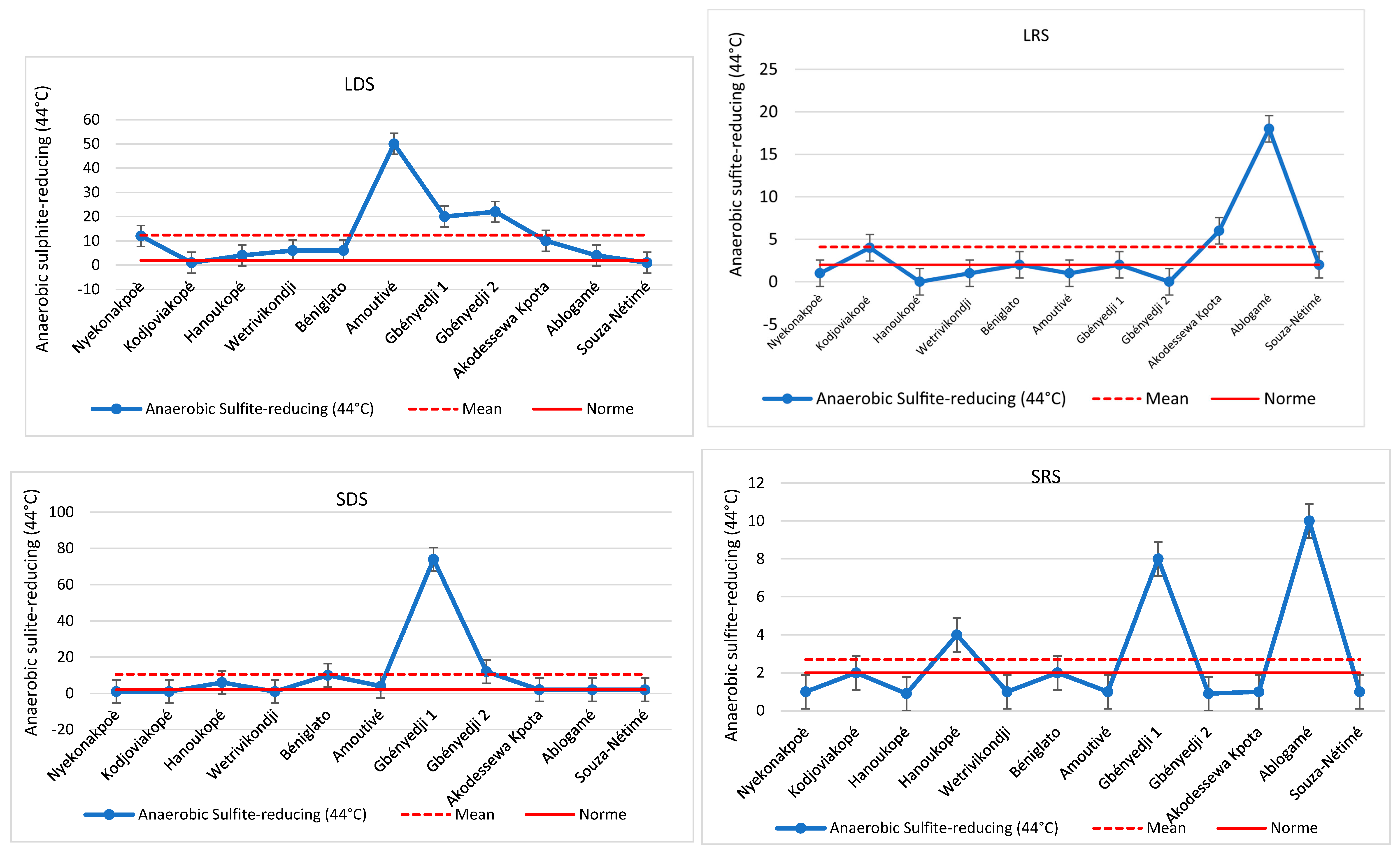
| Parameters | Role |
|---|---|
| Bacteriological parameters | |
| Total germs (30 °C) | Also known as total aerobic mesophilic flora germs, they provide information on the general wholesomeness (hygienic conditions of preparation or production) of a product, water, etc. |
| Total coliforms (30 °C) (44 °C) | Total coliforms are considered test germs for fecal contamination. |
| Escherichia coli (44 °C) | E. coli is of intestinal origin and may also be of fecal origin or originate from soil or plants. Its presence in well water is considered an indication of pollution. |
| Fecal streptococci (37 °C) | Fecal streptococci provide confirmation of the nature of fecal pollution. |
| Anaerobic sulfite reducer | Used as an indicator of previous faecal pollution. |
| Physicochemical parameters | |
| Temperature | Temperature regulates the maximum concentration of dissolved oxygen in water and influences the rate of chemical and biological reactions. |
| pH | Corresponds to the concentration of H+, the hydrogen potential, and determines whether the water is acidic or basic. |
| Electrical conductivity | The ability to conduct electricity. It is used to assess the quantity of mineral substances dissolved in ionic form. |
| Turbidity | Water disorder and poor light penetration, affecting photosynthesis. |
| Calcium (Ca2+) Magnesium (Mg2+) Sodium (Na+) Potassium (K+) | Cations are among the major ions in water: calcium, magnesium, sodium, and potassium. These are the major components that determine the hardness of water, particularly calcium and magnesium. They are linked to the rock formations crossed (limestone, dolomite). |
| Nitrates (NO3−) Chlorides (Cl−) Sulfates (SO42−) | These are the anions that make up the major ions in water. A high chloride and sulfate content intensifies the corrosiveness of water. Chlorides express the quantity of the chloride ion (Cl−) present in the water and help to determine the overall salinity of the water. |
| Carbonates (CO32−) Bicarbonates (HCO3) | These parameters play a role in stabilizing the pH. |
| Nitrate/nitrite (NO2) Ammonium (NH4+) | Nitrogenous matter represents the sum of organic and ammoniacal nitrogen; its presence indicates nitrogenous mineral pollution. |
| Oxidizable materials (KMnO4) Orthophosphates (PO43−) | Used to estimate total organic pollution. |
| T °C | pH | Cond. Elec. 25 °C—µs/cm | Dissolved Solids—mg/L | Nitrates (NO3)—mg/L | Nitrites (NO2−)—mg/L | Chloride (Cl−)—mg/L | |
|---|---|---|---|---|---|---|---|
| Nyekonakpoè | 27.60 | 7.20 | 2532.50 | 1919.50 | 33.40 | 0.30 | 354.15 |
| Kodjoviakopé | 27.70 | 7.40 | 994.00 | 753.50 | 93.30 | 0.60 | 133.15 |
| Hanoukopé | 28.10 | 7.10 | 2197.50 | 1740.80 | 14.30 | 0.10 | 499.35 |
| Wetrivikondji | 28.00 | 7.10 | 829.00 | 671.30 | 107.00 | 0.30 | 90.88 |
| Béniglato | 27.90 | 7.40 | 1137.30 | 861.50 | 27.10 | 1.80 | 153.93 |
| Amoutivé | 27.50 | 7.20 | 1144.30 | 867.50 | 70.60 | 1.90 | 115.13 |
| Gbényédji 1 | 27.50 | 7.20 | 1792.00 | 1358.50 | 99.20 | 3.20 | 219.93 |
| Gbényédji 2 | 27.40 | 7.20 | 1160.80 | 880.00 | 104.30 | 2.00 | 157.18 |
| Akodessewa Kpota | 27.60 | 7.20 | 2384.00 | 1807.30 | 191.40 | 1.30 | 193.95 |
| Ablogame | 27.60 | 7.20 | 1553.50 | 1177.80 | 140.70 | 1.40 | 203.45 |
| Souza Nétimé | 27.60 | 7.20 | 1153.80 | 874.50 | 127.90 | 1.50 | 113.85 |
| Mean | 27.68 | 7.22 | 1534.43 | 1173.84 | 91.75 | 1.31 | 203.18 |
| SD | ±0.22 | ±0.11 | ±600.71 | ±459.28 | ±53.02 | ±0.93 | ±121.93 |
| Min | 27.40 | 7.10 | 829.00 | 671.30 | 14.30 | 0.10 | 90.88 |
| Max | 28.10 | 7.40 | 2532.50 | 1919.50 | 191.40 | 3.20 | 499.35 |
| Quartier | Total Germs (30 °C) 100/mL | Total Coliforms (30 °C) 0/mL | Escherichia coli (44 °C) 2/250 mL | Fecal Streptococcus 0/100 mL | Sulfite-Reducing Anaerobes (44 °C) 2/20 mL |
|---|---|---|---|---|---|
| Nyekonakpoè, LRS | 1.66 | 1 | 1 | 1 | 1 |
| Nyekonakpoè, SDS | 2800 | 22 | 2 | 1 | 1 |
| Nyekonakpoè, SRS | 3700 | 6 | 1 | 4 | 1 |
| Nyekonakpoè, LDS | 8500 | 3 | 1 | 2 | 12 |
| Kodjoviakopé, LRS | 2.94 | 72 | 6 | 5 | 4 |
| Kodjoviakopé, SDS | 4300 | 59 | 1 | 118 | 1 |
| Kodjoviakopé, SRS | 3200 | 210 | 1 | 3 | 2 |
| Kodjoviakopé, LDS | 4100 | 7 | 1 | 12 | 1 |
| Hanoukopé, LRS | 39,000 | 1000 | 112 | 41 | <1 |
| Hanoukopé, SDS | 16,000 | 110 | <1 | 42 | 6 |
| Hanoukopé, SRS | 1400 | 66 | <1 | 11 | <1 |
| Hanoukopé, LDS | 3600 | 18 | 1 | 2 | 4 |
| Wetrivikondji, LRS | 15,000 | 84 | 1 | 1 | 1 |
| Wetrivikondji, SDS | 1800 | 61 | 1 | 1 | 1 |
| Wetrivikondji, SRS | 330 | 11 | 1 | 1 | 1 |
| Wetrivikondji, LDS | 3000 | 30 | 1 | 38 | 6 |
| Béniglato, LRS | 740 | 14 | <1 | <1 | 2 |
| Béniglato, SDS | 12,000 | 22 | <1 | 1 | 10 |
| Béniglato, SRS | 900 | 5 | 1 | 2 | 2 |
| Béniglato, LDS | 14,000 | 6 | <1 | 2 | 6 |
| Amoutivé, LRS | 5000 | 17 | 1 | 1 | 1 |
| Amoutivé, SDS | 200,000 | 180 | 1 | 2 | 4 |
| Amoutivé, SRS | 2300 | 60 | 1 | 18 | 1 |
| Amoutivé, LDS | 7700 | 52 | 1 | 1 | 50 |
| Gbényedji 1, LRS | 36,000 | 2 | 1 | 8 | 2 |
| Gbényedji 1, SDS | 120,000 | 430 | 1 | 4 | 74 |
| Gbényedji 1, SRS | 3600 | 37 | 1 | 9 | 8 |
| Gbényedji 1, LDS | 14,000 | 240 | 1 | 4 | 20 |
| Gbényedji 2, LRS | 4000 | 5 | <1 | <1 | <1 |
| Gbényedji 2, SDS | 30,000 | 80 | <1 | 2 | 12 |
| Gbényedji 2, SRS | 50,000 | 260 | <1 | <1 | <1 |
| Gbényedji 2, LDS | 5500 | 38 | <1 | 51 | 22 |
| Akodessewa Kpota, LRS | 1930 | 42 | 13 | 3 | 6 |
| Akodessewa Kpota, SDS | 1900 | 83 | 5 | 20 | 2 |
| Akodessewa Kpota, SRS | 1000 | 100 | 68 | 21 | 1 |
| Akodessewa Kpota, LDS | 4000 | 16 | 1 | 23 | 10 |
| Ablogamé, LRS | 5000 | 15 | 1 | 1 | 18 |
| Ablogamé, SDS | 2100 | 100 | 1 | 1 | 2 |
| Ablogamé, SRS | 2700 | 42 | 1 | 1 | 10 |
| Ablogamé, LDS | 9600 | 40 | 1 | 4 | 4 |
| Souza-Nétimé, LRS | 5000 | 7 | 1 | 3 | 2 |
| Souza-Nétimé, SDS | 7500 | 39 | 1 | 12 | 2 |
| Souza-Nétimé, SRS | 2900 | 31 | 1 | 1 | 1 |
| Souza-Nétimé, LDS | 6700 | 95 | 1 | 1 | 1 |
| Min | 1.66 | 1 | 1 | 1 | 1 |
| Mean | 15,063.7 | 86,8 | 6,7 | 11,7 | 7.9 |
| Max | 200,000 | 1000 | 112 | 118 | 74 |
| SD | ±34,859.9 | ±163.8 | ±21.6 | ±21.3 | ±14.0 |
| Standard OMS | 100/mL | 0/mL | 2/250 mL | 0/100 mL | 2/20 mL |
| Season | LRS | SDS | SRS | LDS | LRS | SDS | SRS | LDS | LRS | SDS | SRS | LDS |
| Quartier | Nyekonakpoè | Nyekonakpoè | Nyekonakpoè | Nyekonakpoè | Kodjoviakopé | Kodjoviakopé | Kodjoviakopé | Kodjoviakopé | Hanoukopé | Hanoukopé | Hanoukopé | Hanoukopé |
| R = CT/SF | ||||||||||||
| Season | LRS | SDS | SRS | LDS | LRS | SDS | SRS | LDS | LRS | SDS | SRS | LDS |
| Quartier | Wetrivikondji | Wetrivikondji | Wetrivikondji | Wetrivikondji | Béniglato | Béniglato | Béniglato | Béniglato | Amoutivé | Amoutivé | Amoutivé | Amoutivé |
| R = CT/SF | ||||||||||||
| Season | LRS | SDS | SRS | LDS | LRS | SDS | SRS | LDS | LRS | SDS | SRS | LDS |
| Quartier | Gbényedji 1 | Gbényedji | Gbényedji 1 | Gbényedji 1 | Gbényedji 2 | Gbényedji 2 | Gbényedji 2 | Gbényedji 2 | Akodessewa | Akodessewa | Akodessewa | Akodessewa |
| R = CT/SF | ||||||||||||
| Season | LRS | SDS | SRS | LDS | LRS | SDS | SRS | LDS | ||||
| Quartier | Ablogamé | Ablogamé | Ablogamé | Ablogamé | Souza-Nétimé | Souza-Nétimé | Souza-Nétimé | Souza-Nétimé | ||||
| R = CT/SF | ||||||||||||
| Uncertain origin | human contamination | animal contamination | mixed origin | |||||||||
Disclaimer/Publisher’s Note: The statements, opinions and data contained in all publications are solely those of the individual author(s) and contributor(s) and not of MDPI and/or the editor(s). MDPI and/or the editor(s) disclaim responsibility for any injury to people or property resulting from any ideas, methods, instructions or products referred to in the content. |
© 2025 by the authors. Licensee MDPI, Basel, Switzerland. This article is an open access article distributed under the terms and conditions of the Creative Commons Attribution (CC BY) license (https://creativecommons.org/licenses/by/4.0/).
Share and Cite
Houédakor, K.Z.; Adjalo, D.K.; Danvide, B.; Totin Vodounon, H.S.; Amoussou, E. Groundwater Characteristics and Quality in the Coastal Zone of Lomé, Togo. Water 2025, 17, 1813. https://doi.org/10.3390/w17121813
Houédakor KZ, Adjalo DK, Danvide B, Totin Vodounon HS, Amoussou E. Groundwater Characteristics and Quality in the Coastal Zone of Lomé, Togo. Water. 2025; 17(12):1813. https://doi.org/10.3390/w17121813
Chicago/Turabian StyleHouédakor, Koko Zébéto, Djiwonou Koffi Adjalo, Benoît Danvide, Henri Sourou Totin Vodounon, and Ernest Amoussou. 2025. "Groundwater Characteristics and Quality in the Coastal Zone of Lomé, Togo" Water 17, no. 12: 1813. https://doi.org/10.3390/w17121813
APA StyleHouédakor, K. Z., Adjalo, D. K., Danvide, B., Totin Vodounon, H. S., & Amoussou, E. (2025). Groundwater Characteristics and Quality in the Coastal Zone of Lomé, Togo. Water, 17(12), 1813. https://doi.org/10.3390/w17121813






